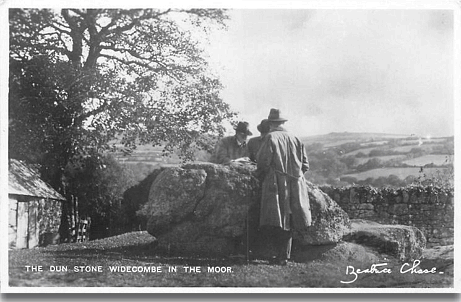
Just outside Widecombe-in-the- Moor is Lower Dunstone which today is just a small collection of houses. On a tiny triangular green stand two granite artefacts, one is a granite cross and the other is a huge boulder called ‘The Dun Stone’ or alternatively the ‘Rent Stone’. On early Ordnance Survey maps the stone appears to have been promoted for on these it appears as Dunstone Rock. Crossing notes that how in former times the manor courts were held at this stone and the custom was that the chief rents were deposited in the hollow that is on top of the boulder. In later years it was the dreaded annual tithes that were collected at the stone. It is thought that the settlement of Dunstone originally took its name from the boulder. There is part of a poem written by a local poet which goes:
“… huge granite block has basin on th’ top
Manor Courts held there;
Some sat round, some sat on th’ top,
Chief rents and due deposit there
in th’ hewn basin on the rock.“
Below is an early postcard taken by Beatrice Chase for the postcard manufacturers Raphael Tuck Ltd. On the back is written : “The Manor of Dun Stone Widecombe in the Moor is the only one which still adheres to the ancient custom of paying head rents on a prehistoric stone. Every five years, at the court meeting, each commoner stands on one side of the stone to pay his rent to the stewards on the other side.”

Early Postcard by Tuck
First documented in the Domesday Book as Dunsestanetuna in 1086, Gover et al., consider that the place-name could be ‘farm by the dünstän or hill-rock or alternatively the dun derived from the Old English word – Dunn, meaning grey, which would be ‘farm by the grey rock’. Therefore it is logical to assume that The Dunstone means the ‘grey rock’ which there is no denying.

Tradition has it that during times of plague or pestilence the depressions in the rock would be filled with vinegar in the hope that it would ‘disinfect’ any coins that were placed in it and help prevent the spread of disease.

Brewer, D. 2002 Dartmoor Boundary Markers, Halsgrove Publishing, Tiverton.
Crossing, W. 1987 The Ancient Stone Crosses of Dartmoor, Devon Books, Exeter.
Gover, J.E.B., Mawer, A., & Stenton, F. M. 1992 The Place-Names of Devon, The English Place Name Society, Nottingham.
Harrison, B. 2001 Dartmoor Stone Crosses, Devon Books/Halsgrove, Tiverton.
 Legendary Dartmoor The many aspects past and present of Dartmoor
Legendary Dartmoor The many aspects past and present of Dartmoor

In the early years of the 20th century a house called Dunstone House overlooked Paignton in the direction of Torquay. I can find no pictures of it and few references. At that time, most of the land between it and the coast was a golf course. The stone in Paignton is mostly red, so I wonder whether there is a connection between the house and the hamlet/village. It could also, f course, have something to do with St Dunstan…